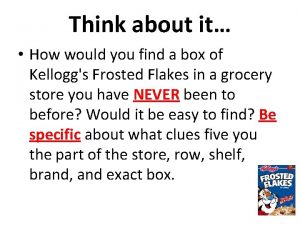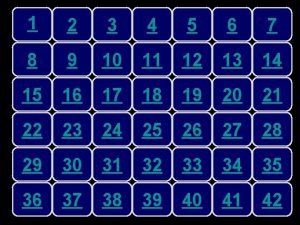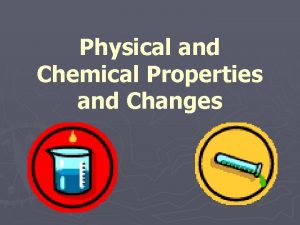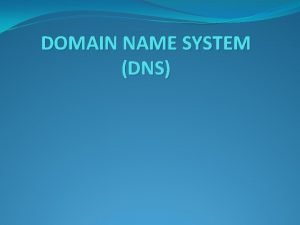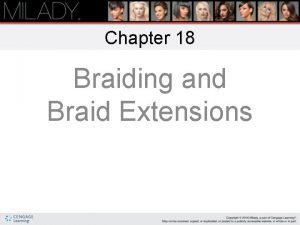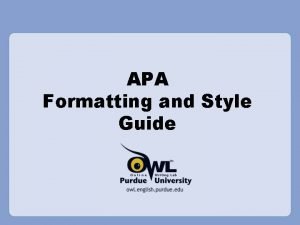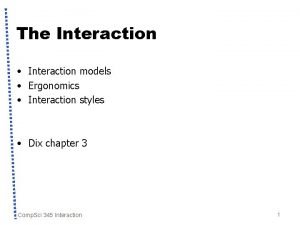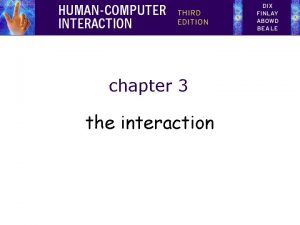Topic 17 Interaction Models Interaction Models With several



















- Slides: 19

Topic 17: Interaction Models

Interaction Models • With several explanatory variables, we need to consider the possibility that the effect of one variable depends on the value of another variable • Special cases – One binary variable (Y/N) and one continuous variable – Two continuous variables

One binary variable and one continuous variable • X 1 takes values 0 and 1 corresponding to two different groups • X 2 is a continuous variable • Model: Y = β 0 + β 1 X 1 + β 2 X 2 + β 3 X 1 X 2 + e • When X 1 = 0 : Y = β 0 + β 2 X 2 + e • When X 1 = 1 : Y = (β 0 + β 1)+ (β 2 + β 3) X 2 + e

One binary and one continuous • β 0 is the intercept for Group 1 • β 0+ β 1 is the intercept for Group 2 • Similar relationship for slopes (β 2 and β 3) • H 0: β 1 = β 3 = 0 tests the hypothesis that the regression lines are the same • H 0: β 1 = 0 tests equal intercepts • H 0: β 3 = 0 tests equal slopes

KNNL Example p 316 • Y is number of months for an insurance company to adopt an innovation • X 1 is the size of the firm (a continuous variable • X 2 is the type of firm (a qualitative or categorical variable)

The question • X 2 takes the value 0 if it is a mutual fund firm and 1 if it is a stock fund firm • We ask whether or not stock firms adopt the innovation slower or faster than mutual firms • We ask the question across all firms, regardless of size

Plot the data symbol 1 v=M i=sm 70 c=black l=1; symbol 2 v=S i=sm 70 c=black l=3; proc sort data=a 1; by stock size; proc gplot data=a 1; plot months*size=stock; run;

Two symbols on plot

Interaction effects • Interaction expresses the idea that the effect of one explanatory variable on the response depends on another explanatory variable • In the KNNL example, this would mean that the slope of the line depends on the type of firm

Are both lines the same? • From scatterplot, looks like different intercepts but can use the test statement formal assessment Data a 1; set a 1; sizestock=size*stock; Proc reg data=a 1; model months=size stock sizestock; test stock, sizestock; run;

Output Test 1 Results for Dependent Variable months Source Numerator Denominator Mean DF Square 2 158. 12584 16 11. 02381 F Value 14. 34 Pr > F 0. 0003 Reject H 0. There is a difference in the linear relationship across groups

Output • How are they different? Parameter Estimates Variable Intercept size stock sizestock DF 1 1 Parameter Estimate 33. 83837 -0. 10153 8. 13125 -0. 00041714 Standard Error 2. 44065 0. 01305 3. 65405 0. 01833 t Value 13. 86 -7. 78 2. 23 -0. 02 Pr > |t| <. 0001 0. 0408 0. 9821 1. No difference in slopes assuming different intercepts 2. Potentially different intercepts assuming different slopes

Two parallel lines? proc reg data=a 1; model months=size stock; run;

Output Analysis of Variance Source Model Error Sum of Mean DF Squares Square F Value Pr > F 2 1504. 4133 752. 2066 72. 50 <. 0001 17 176. 38667 10. 37569 Corrected Total 19 1680. 8000 Root MSE 3. 22113 R-Square 0. 8951 Dependent Mean 19. 40000 Adj R-Sq 0. 8827 Coeff Var 16. 60377

Output Parameter Estimates Variable Intercept DF 1 Parameter Standard Estimate Error t Value Pr > |t| 33. 87407 1. 81386 18. 68 <. 0001 size 1 -0. 10174 0. 00889 -11. 44 <. 0001 stock 1 8. 05547 1. 45911 5. 52 <. 0001 Int for stock firms is 33. 87+8. 05 = 41. 92 Common slope is – 0. 10

Plot the two fitted lines symbol 1 v=M i=rl c=black l=1; symbol 2 v=S i=rl c=black l=3; proc gplot data=a 1; plot months*size=stock; run;

The plot

Two continuous variables • • • Y = β 0 + β 1 X 1 + β 2 X 2 + β 3 X 1 X 2 + e Can be rewritten as follows Y = β 0 + (β 1 + β 3 X 2)X 1 + β 2 X 2 + e Y = β 0 + β 1 X 1 + (β 2 + β 3 X 1) X 2 + e The coefficient of one explanatory variable depends on the value of the other explanatory variable

Last slide • We went over KNNL 8. 2 – 8. 7 • We used programs Topic 17. sas to generate the output for today
 A clincher sentence is
A clincher sentence is Broad topic and specific topic examples
Broad topic and specific topic examples Topic models
Topic models Models of interaction in hci
Models of interaction in hci Modals and semi modals
Modals and semi modals Contains several layers of polygonal keratinocytes
Contains several layers of polygonal keratinocytes Multiplying and dividing uncertainties
Multiplying and dividing uncertainties Dating patterns since the 1960s are
Dating patterns since the 1960s are Linnaeus system of classification is
Linnaeus system of classification is Construction of the union pacific railroad pushed west from
Construction of the union pacific railroad pushed west from The color of a sunset physical or chemical
The color of a sunset physical or chemical Domain kingdom phylum
Domain kingdom phylum Examples of domain name
Examples of domain name There are several ways
There are several ways A firm that uses blank segmentation divides
A firm that uses blank segmentation divides Probability vs non probability sampling
Probability vs non probability sampling A switch combines crossbar switches in several stages
A switch combines crossbar switches in several stages Extension fibers hackles and drawing boards
Extension fibers hackles and drawing boards Pronoun and antecedent
Pronoun and antecedent Intext citations apa
Intext citations apa








